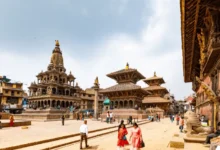Ascending Uhuru: A Kilimanjaro Hike Preparation Guide
As Africa’s highest and most prestigious mountain, climbing Mount Kilimanjaro is a huge undertaking that takes a fair bit of preparation. Even if you’re a relatively fit and healthy person, climbing a mountain of this size will test you both mentally and physically.
With this in mind, it’s 100 percent achievable to reach the summit of Kilimanjaro with enough preparation. In fact, summiting success rates hover around the mark, depending on the route you choose.
If you’ve always dreamed of conquering a Mount Kilimanjaro hike, this is the ultimate guide to help you prepare.
Getting To Know Mount Kilimanjaro
Situated in Northern Tanzania, Mount Kilimanjaro sits slap, bang in the middle of the Kilimanjaro National Park as the world’s tallest free-standing mountain. With an altitude of 19,341 feet (5,895 meters), you cannot mistake its grand presence that watches over the open Tanzanian plains below.
The mountain is actually a dormant volcano and boasts three separate volcanic cones, known as Shira, Mawenzi, and Kibo — with its iconic summit known as Uhuru (which means ”freedom” in Swahili).
If you had to compare the size of Mount Kilimanjaro to Mount Everest, most people are surprised to know that it’s not that far off. While the summit of Kilimanjaro stands at 19,341 feet, the summit of Mount Everest stands at 29,029 feet. In meters, Mount Everest is only 2,950 meters taller.
This might give you a rough idea of why preparation is so important when you plan to climb Kilimanjaro. And your first place is to start is to understand the different routes to choose from…
Picking the Right Route for Your Kilimanjaro Hike
Officially, there are 7 different routes to choose from in order to summit this iconic peak. The key to summiting success is choosing the right route, as each one has its own level of difficulty and skill requirements. All in all, the recommended amount of time you need to submit this mountain is 7-8 days.
Southern Circuit Routes: Lemosho
This is probably one of the most popular and successful routes for climbers of all capabilities. With the Lemosho route, you begin your hike on the far western end of the mountain, and it should take a total of 7-8 days to summit and descend the mountain.
This is the best route for acclimatization, especially if this is your first major mountain hike. This route has a great summit success rate, so you want to opt for the Lemosho route as a rookie hiker.
Machame
Beginning on the southwest side of the mountain, you start at a lower altitude than the Lemosho route, so acclimatization is a little easier. You can also complete a successful summit and descent of the mountain in 6-7 days, depending on how well you acclimatize.
Just like the Lemosho route, this is one of the most popular choices among hikers of all capabilities and fitness levels. It’s also beautifully scenic.
Marangu
If you’re looking for a few creature comforts of home along your hike, then this is the best route to choose. The Marangu Route is the only one that offers hut accommodation along the way and not tents. Hence the reason it’s the most popular.
It’s a great route and a little cheaper than some of the others, however, the summit success rates are not as high. This is because acclimatization can be a little more strenuous. This is why you want to opt for a longer itinerary, such as the 6-day route, and not the 5-day route.
The Northern Circuit
If you’re interested in climbing Kilimanjaro and not encountering any crowds along the way, this is the best route to choose. It’s the quietest route by a mile, but it’s also the longest.
Starting on the Lemosho trail, you then traverse across the north side of the mountain and approach Uhuru Peak via a track known as Gilman’s Point. If you have the time and can afford the expense of this circuit, then go for it.
The Rongai Route
This is the only circuit that does not begin in Tanzania, but rather, from the north at the Kenyan border. If you’re strapped for time on when to climb throughout the year, this is one of the best routes to consider.
This northern route tends to sit in the rain shadow, so you can even climb it during the rainy season. You can also snap some of the best low-lying images of Mount Kilimanjaro from this route.
Choosing the Best Time of Year for Your Climb
Weather is a huge consideration to keep in mind when you plan a hike of this caliber, on a mountain this size. It’s so important that it can actually determine your summit success.
With this in mind, you want to plan your Kilimanjaro hike during the following months:
- January-March — this time of year the weather is stable and dry, however, it can be chilly and there might be snow at the summit
- June-October — this is the busiest season on the mountain as the weather coincides with the European summer holidays. This is the best time to hike Kilimanjaro as the weather is good, stable, and dry
If you want to avoid the rainy season, then don’t plan your trek during the months of April-May. Not only will you experience heavy rainfall, but heavy cloud cover could impair your visibility.
November-December is the shoulder season and is actually a good time to schedule your hike if you plan on taking the Rongai route. It is lightly rainy and can be very cold at the summit, but otherwise, the weather plays along.
Planning Out Your Budget
It’s no secret that embarking on any significant mountain trek is no cheap endeavor. Whether you plan on hiking Kilimanjaro, the Swiss Alps, or Mount Everest, your budget is a massive consideration.
So, what does a Kilimanjaro hike cost, roughly? As of 2021, you want to budget anywhere between $2,000-$3,000 for the trek alone. This does not include your travel expenses, possible visas, and any onward travel after your hike.
Back in the 1990s, it cost very little to summit the mountain, but back then, the climb was all on you, and you alone.
Nowadays, your Kilimanjaro trek includes a great amount of support in the form of porters, registered trek guides, and cooks. As well as your park entrance fees. All of these costs add up.
Understanding the Summit Success Rate
As with any major hike you embark on, there’s always a chance that you won’t make it to the summit. This is a reality you’ll have to think about and accept before you embark on a Kilimanjaro hike.
At times, summit success might be out of your hands. This might be due to poor weather, but if you choose the right time of year, these chances are minimal. Other times, you might not be able to acclimatize like you thought you would, and summiting may not be an option for you due to health concerns.
If you go with a determination that you’ll summit, this is a great attitude. But it’s also important to make peace with the fact that you might not make the summit, and the experience of it all is what counts.
Summit success rates vary between 45-65 percent, depending on the route you choose, as mentioned. What’s important to keep in mind is that success rates tend to be higher when you choose to spend longer on the mountain. These extra days give your body time to acclimatize and you can avoid them.
Unfortunately, this is a reality that many climbers face, and it’s one of the main issues that some people do not make it to the summit. The trek up Kilimanjaro is at a high altitude, while the ascent itself is pretty rapid, especially if you choose a shorter route.
Before you choose your route, think about the reality of altitude sickness versus comfort versus how much time you have to spend on ascending. At the end of the day, the longer your trek, the lower your risk of altitude sickness.
All the Gear and No Idea: What You Really Need to Pack
The last thing you want to do before a climb like Mount Kilimanjaro is over-pack. The porters that carry your gear up the mountain are super-human fit. But only because they are 100 percent acclimated to the mountain and have done each route numerous times.
Nevertheless, they’re still human and they are the ones that have to lug your gear up and down — so if anything, spare a thought for them! However, there are some crucial items you will definitely need along the way:
- Clothing — you’ll need fully waterproof gear, and layering your clothing is best as the weather changes quickly on the mountain. Choose moisture-wicking fabrics such as wool, and avoid cotton
- Headgear — this includes peaks and beanies as well as a reliable headlamp and trekking sunglasses
- Shoes — this is probably your most important thing to consider. Invest in high-quality and socks, and make sure to wear them in before your hike!
- Hiking accessories — invest in a pair of top-quality gloves for early mornings, evenings, and the summit, as well as trekking poles
- A Kilimanjaro duffel bag — this will include all of your personal gear and is carried by your porter (on their heads!). Make sure it does not weigh more than 44 pounds (20kgs).
- A daypack — you carry this bag yourself and it will include your water, rain gear, snacks, and more. Keep it lightweight and stick to a 20/22 liter capacity
- A sleeping bag — always opt for a warm sleeping bag, no matter the time of year you choose to climb. Go with a down sleeping back that’s suitable for negative temperatures
Other Essential Items
The above items are your absolute ride or die essentials and will determine your success and comfort along your hike. But aside from these important bits of gear to pack, you’ll also need these essentials:
- A good-quality water bottle, preferably with a straw attachment
- A water bladder for inside your daypack
- Water purification tablets
- Sweat-proof sunscreen
- Plenty of wet wipes and hand sanitizer
- Earplugs to help switch off and sleep well at night
- Spare batteries for your headlamp and an extra power bank for a phone or camera
- Ziploc bags protect your valuables such as your camera, cellphone, wallet, etc.
- Energy drink sachets and energy bars
- All necessary medications (including anti-inflammatories)
- Blister Band-Aids
- Insect repellent
- A small first-aid kit
A pro packing tip to keep in mind: separate your main items into dry bags. This way, you can find things easily as you need them and separate dirty from clean clothing. Take note that plastic bags are a no-go on the mountain, so you’ll need to purchase separate dry bags.
Physical and Mental Training for Kilimanjaro
So, by now, you should already know that climbing Mount Kilimanjaro is no easy feat. While you can submit the mountain with relatively good fitness levels, you’d be a fool not to prepare for your trek with some training, beforehand.
At the end of the day, it’s this training that increases your chances of summit success and reduces your risk of altitude sickness. Ideally, you want to begin training for your climb 6-8 weeks beforehand.
You should aim to improve your cardiovascular fitness. Some of the best exercises includes long-distance trail walking, incline walking up hills, aerobic gym workouts, running, and swimming. It’s also a good idea to strengthen your leg muscles with some strength/weighted work.
Mental Preparation
Summiting a mountain like Kilimanjaro is a physical feat, but it’s also a mental game. In fact, some people might argue that it’s far more strenuous in a mental capacity than it is physical.
This is why mental preparation is so crucial to your summit success. A good way to challenge your mental capacity and build strength is by pushing yourself in your physical training. This helps to increase your capacity for overcoming stress and strain.
Another great way to enhance your mental stamina is. This can help you to find a sense of calm and level-headedness when the climb starts to feel overwhelming. You also want to work on adopting a positive attitude. This is the best way to overcome unexpected obstacles along your trek — and yes, there will be plenty.
It’s a great idea to test your gear before you use it, too. Make sure to wear your trekking boots whenever you go on long-distance walks or smaller hikes. Wear them in so that your feet get used to them before Kilimanjaro!
Test out your sleeping bag and what your daypack feels like when it’s packed to the brim. Figure out how your water bladder works research the best snacks for energy and finally, get some good rest in the lead-up to your trek.
Are You a Travel Fanatic?
Planning for a Kilimanjaro hike begins at least 6 weeks before you embark on this once-in-a-lifetime adventure. This might sound excessive, but the better prepared you are, the better your chance of reaching Uhuru and ticking off that incredible achievement!
If you have a passion for travel, be sure to explore the rest of this site for your fix. Learn more about the world’s most popular summits, hiking routes, and more…












